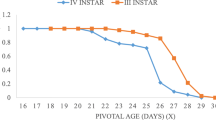Abstract
The effect of four cotton cultivars on the oviposition behavior of the pink bollworm Pectinophora gossypiella (Saunders) was studied under laboratory and semi-field conditions. Young plants and bolls from four commercial upland cotton cultivars (Lachata, Macnair-220, Midas and Sandra) cultivated in the area of Thessaloniki were used. The four cultivars had palmate leaves, and nectaries on both leaves and bolls. Differences were observed in the trichome density and the length of leaf petiole among the cultivars. The typical shape of bolls was either round or ovate. Differences were observed among the cultivars tested in boll size and bract’s length. In a series of experiments we recorded the number of eggs oviposited in no-, two-, three-, and four-choice tests using either young plants or bolls. Although the four cotton cultivars exhibited a variation in morphological characteristics, the mean number of eggs oviposited on young plants and bolls did not differ among them in two-, three-, and four-choice experiments. Substantially higher number of eggs were oviposited on either young plants or bolls of Midas in no-choice experiments. Eggs were oviposited mainly on newly developed unfolded leaves of the young plants and under the calyx of the bolls. In a semi-field experiment, we found a clear oviposition preference for bolls compared with plant terminals in all the cultivars tested. Females oviposited similar number of eggs in the four cultivars. We discuss the effect of morphological characteristics of cotton cultivars on the oviposition behavior of pink bollworm.
Similar content being viewed by others
References
Brazzel JR, Martin DF (1957) Oviposition sites of the pink bollworm on the cotton plant. J Econ Entomol 50:122–124
Brazzel JR, Martin DF (1959) Pink bollworm resistance in cotton. J Econ Entomol 52:385–390
Carriere Y, Ellers-Kirk C, Patin AL, Sims MA, Meyer S, Liu YB, Dennehy TJ, Tabashnik BE (2001) Overwintering cost associated with resistance to transgenic cotton in the pink bollworm (Lepidoptera: Gelechidae). J Econ Entomol 94:935–941
Chatzigeorgiou AC (2006) Bioecological study of pink bollworm Pectinophora gossypiella (Saunders) in Northern Greece. PhD dissertation, Aristotle University of Thessaloniki, Greece
Flint HM, Curtice NJ, Wilson FD (1988) Development of pink bollworm populations (Lepidoptera: Gelechiidae) on nectaried and nectariless Deltapine cotton in field cages. Environ Entomol 17:306–308
Flint HM, Wilson FD, Parks NJ, Reynoso RY, Stapp BR, Szaro JL (1992) Suppression of pink bollworm and effect on beneficial insects of a nectariless okra-leaf cotton germplasm line. Bull Entomol Res 82:379–384
Heneberry TJ, Clayton TE (1982) Pink Bollworm: seasonal oviposition, egg predation, and square and boll infestations in relation to cotton plant development. Environ Entomol 11:663–666
Katsoyannos BI, Pittara IS (1983) Effect of size of artificial oviposition substrates and presence of natural host fruits on the selection of oviposition site by Dacus oleae. Entomol Exp Appl 34:326–332
Lukefahr MJ, Griffin J (1957) Mating and oviposition habits of the pink bollworm moths. J Econ Entomol 50:487–490
Lukefahr MJ, Martin DF, Meyer JR (1965) Plant resistance to five Lepidoptera attacking cotton. J Econ Entomol 58:516–518
Lukefahr MJ, Houghtaling JE, Graham HM (1971) Suppression of Heliothis populations with glabrous cotton strains. J Econ Entomol 64:486–488
Lukefahr MJ, Houghtaling JE, Cruhm DG (1975) Suppression of Heliothis spp. with cottons containing combinations of resistant characters. J Econ Entomol 68:743–746
Naranjo SE, Martin JM (1993) Comparative development, reproduction, and oviposition of pink bollworm (Lepidoptera: Gelechiidae) on a resistant okra-leaf cotton and commercial upland and pima cultivars. J Econ Entomol 86:1094–1103
Renwick JAA, Chew FS (1994) Oviposition behavior in Lepidoptera. Ann Rev Entomol 39:377–400
Shiller I, Noble LW, Fife LC (1962) Host plants of the pink bollworm. J Econ Entomol 55:67–70
Smith RL, Wilson RL, Wilson FD (1975) Resistance of cotton plant hairs to mobility of first-instars of the pink bollworm. J Econ Entomol 68:679–683
Sokal RR, Rohlf FJ (1995) Biometry. Freedman & Company, New York
SPSS (2003) SPSS® Base 12.0 user’s guide. Copyright 2003 by SPSS, Chicago, IL, 703 pp
UPOV—International Union for the Protection of new varieties of Plants. (2001) Guidelines for the conduct of tests for distinctness, uniformity and stability. Cotton (Gossypium L.) TG/88/6. Geneva, Switzerland
Vaissayre M (1995) Ecological attributes of major cotton pests: implications for management. In: Constable GA, Forrester NW (eds) Challenging the future. Proceedings of the world cotton research conference I, 14–17 February 1994, Brisbane, Australia. CSIRO, Australia, pp 499–510
Wilson FD (1986) Pink bollworm resistance, lint yield, and lint yield components of okra-leaf cotton in different genetic backgrounds. Crop Sci 26:1164–1167
Wilson FD, George BW (1982) Effects of okra-leaf, frego bract, and smooth-leaf mutants on pink bollworm damage and agronomic properties of cotton. Crop Sci 22:798–801
Wilson RL, Wilson FD (1976) Nectariless and glabrous cottons: effects on pink bollworm in Arizona. J Econ Entomol 69:623–624
Wilson RL, Wilson FD, Abel GH Jr (1977) Mutants of Gossypium barbadense: effect on pink bollworm and cotton leafperforator in Arizona. J Econ Entomol 70:672–674
Wilson RL, Wilson FD, George BW (1979) Mutants of Gossypium hirsutum: effect on pink bollworm in Arizona. J Econ Entomol 72:216–219
Wilson FD, George BW, Szaro JL (1984) Pink bollworm (Lepidoptera: Gelechiidae): oviposition and larval success on resistant and susceptible cotton plants. J Econ Entomol 77:709–714
Wilson FD, George BW, Fry KE, Szaro JL, Henneberry TJ, Clayton TE (1986) Pink bollworm (Lepidoptera: Gelechiidae): egg hatch, larval success, and pupal and adult survival on okra and normal—leaf cotton. J Econ Entomol 79:1671–1675
Author information
Authors and Affiliations
Corresponding author
Additional information
Communicated by T. Zaviezo.
Rights and permissions
About this article
Cite this article
Chatzigeorgiou, A.C., Papadopoulos, N.T. & Prophetou-Athanasiadou, D.A. Effect of cotton cultivars on the oviposition preference of pink bollworm (Lepidoptera: Gelechiidae). J Pest Sci 83, 289–296 (2010). https://doi.org/10.1007/s10340-010-0297-2
Received:
Accepted:
Published:
Issue Date:
DOI: https://doi.org/10.1007/s10340-010-0297-2




